Heterogeneity and Sedimentary Characteristics of Shale Laminae of Fine-Grained Sediments in Alkaline Lacustrine Strata in the Permian Fengcheng Formation, Mahu Sag, NW China
Abstract
1. Introduction
2. Geological Background
3. Samples and Methods
3.1. Samples
3.2. Laminae Division
3.3. Geochemical Analyses
3.4. Mineralogical Composition
3.5. Optical Characteristic Analyses
3.6. Pore Structure Measurements
4. Results
4.1. Types and Combinations of Laminae
- (1)
- Felsic laminae: These are primarily composed of quartz and feldspar, followed by dolomite and pyrite, and appear brown under plane-polarized light. The laminae are 0.2~3 cm thick and contain small numbers of organic matter fragments (Figure 3a). The laminae are straight or curved, and their thickness varies slightly. The particle size is generally less than 100 μm, but wide variations in particle sizes give the laminae a mottled light and dark appearance under plane-polarized light.
- (2)
- Dolomite laminae: These are primarily composed of subangular and subcircular dolomite crystals and are colorless under plane-polarized light. The matrix is a mixture of feldspar, quartz, pyrite, and clay minerals. The particle sizes of the dolomite are 50~150 μm and of the matrix minerals less than 10 μm (Figure 3b). In the penecontemporaneous stage, the formation of micritic–microcrystalline dolomite was induced by alkaline-lake microorganisms. The micritic–microcrystalline dolomites were formed by primary precipitation, the replacement of aragonite and high-Mg calcite, and other processes. In the shallow burial stage, the continuous growth of micritic–microcrystalline dolomite and replacement of calcite, tuffs, and other substances formed the silt-sized dolomite. And in the middle burial stage, the dolomite, mostly silt- and fine-sized, was created by the replacement of volcanic materials with dolomitization fluid [43]. The dolomites of DOL are predominantly silt- and fine-sized. The laminae are more than 0.15 cm thick, with bed-parallel fluctuations, and their boundaries are clear.
- (3)
- Reedmergnerite laminae: The primary visible component under plane-polarized light is reedmergnerite, and the laminae are thick. The reedmergnerite particles are colorless, wedge- or rhombus-shaped, and distributed in starlike configurations. The lengths of individual crystals are less than 2 mm, and the aspect ratios are about 2:1 (Figure 3c). They appear gray-white to yellow under orthogonal light, showing biaxial crystals with extinction characteristics and some symmetrical sections. XRF analysis shows that Na and Si are comparatively enriched in the reedmergnerite, and Na, K, Al, and Si are enriched in the matrix.
- (4)
- Shortite laminae: The principal visible component under plane-polarized light is shortite, and the laminae are thick. Shortite particles are colorless and occur in long strips or agglomerate shapes that are mostly distributed along the laminae in two size ranges (width either >2 cm or <5 mm) (Figure 3d). They are biaxial negative crystals with extinction characteristics and second-order light emissions are red in color under orthogonal light. XRF analysis shows that Na and Ca are enriched alongside the shortite and Na, K, Al, and Si are enriched in the matrix.
- (5)
- Chert laminae: These are primarily composed of chert and are colorless. The laminae are 0.1~1 cm thick (Figure 3e). Qemscan reveals that the laminae also contain small amounts of feldspar and pyrite but seldom organic matter. The laminae are smoothly curved with varying thicknesses and clear boundaries.
4.2. Differences between Laminae
4.2.1. Mineral Composition
4.2.2. Geochemical Characteristics
4.2.3. Pore Characteristics
- (1)
- Pore types and characteristics
- (2)
- Pore size distribution
- (3)
- Porosity
- (4)
- Plane porosity
4.2.4. Lamina Density
4.2.5. Correlation Analysis
4.3. Stratigraphic Organization
5. Discussion
5.1. Laminae Sedimentary Mechanism
5.2. Sedimentary Evolution
- The initial stage of salinization occurred during the late P1f1 and the early P1f2 under semideep lacustrine conditions. The climate was humid and the lake level high, with strong injection of water and weak evaporation [44]. Volcanic activity provided rich nutrients for aquatic organisms, resulting in high organic matter abundance. These reducing conditions were conducive to the accumulation and preservation of organic-rich mudstone. Salinity at this stage was still low and had not yet reached saturation. When the primary stage of salt mineral precipitation began, Ca2+ and Mg2+ combined with CO32− [47] before Na+ and precipitated to form Mg and Ca carbonate minerals that interbedded extensively with the mudstones. In this period, the FQL-DOL combination was well developed, with little development of alkaline minerals (Figure 16).
- The transitional stage of salinization occurred during the early–middle P1f2 deposition under shallow and relatively dry semideep lacustrine conditions. The intensity of water injection was less than evaporation, resulting in falling lake levels. The supply of terrigenous debris was inadequate. With the increasing salinity, the sediments gradually alkalized, accompanied by water stratification. Volcanic activity and microbial consumption also gradually alkalized the water, encouraging Na+ to participate in crystallization to form shortite [12,47]. At the edges of the basin, the most common alkaline mineral was shortite, in low–medium concentrations and with large crystal sizes, indicating the rapid deposition. In this period, the FQL-DOL combination, FQL-SL combination, and DOL-CL combination were well developed. FQL-DOL and FQL-SL combinations formed at the edges of the basin. Towards the center of the basin, the chert bands developed, forming the DOL-CL combination (Figure 16).
- 3.
- The high-level stage of salinization occurred during the middle P1f2 under arid conditions in a shallow lacustrine environment. In this stage, the pH > 9, and hydrothermal fluids and strong microbial activity contributed significantly to salinization and alkalization [12]. As salinity increased, water stratification became more pronounced [51]. With the influx of hydrothermal fluids, evaporative salt minerals developed in large quantities, ushering in a period of great richness of alkaline-bearing sedimentary layers. In an arid climate, the water was further concentrated and salinized, and large amounts of boron combined with hydrothermal fluids to form reedmergnerite [12,47]. When pH values exceed 9, the solubility of silica increases exponentially, so silicate contents dropped dramatically. The FQL-SL/RL combination principally developed during this stage. And the FQL-DOL combination continued to develop during this period in a relatively small percentage.
- 4.
- The recession stage of salinization occurred during the middle–late P1f2 deposition, under semiarid to arid conditions with slightly rising lake levels and decreasing salinity in a shallow lacustrine environment, and the pH < 9 [12,44]. The influx of hydrothermal fluids caused alkaline minerals [12,47], mostly small deposits of shortite and reedmergnerite, to form at the basin edges. The sequence of lamina combinations in this stage was similar to the transitional stage of salinization, with FQL-SL and FQL-DOL forming at the edges of the basin and silicates precipitating to form the DOL-CL combination towards the center of the basin as a result of the decreasing pH.
- 5.
- The late stage of salinization corresponded to the late P1f2 deposition and the early P1f3 deposition and occurred in a shallow–semideep lacustrine environment. The climate was semiarid to semihumid, with rising lake levels and desalinated water. Alkaline minerals gradually disappeared in the weakly oxidizing–weakly reducing environment. In this period, the FQL-DOL combination was well developed, with little development of alkaline minerals.
6. Conclusions
Author Contributions
Funding
Data Availability Statement
Acknowledgments
Conflicts of Interest
References
- Javadpour, F.; Fisher, D.; Unsworth, M. Nanoscale gas flow in shale gas sediments. J. Can. Pet. Technol. 2007, 46, 55–61. [Google Scholar] [CrossRef]
- Chalmers, G.R.; Bustin, R.M.; Power, I.M. Characterization of gas shale pore systems by porosimetry, pycnometry, surface area, and field emission scanning electron microscopy/transmission electron microscopy image analyses: Examples from the Barnett, Woodford, Haynesville, Marcellus, and Doig units. AAPG Bull. 2012, 96, 1099–1119. [Google Scholar]
- Du, J.H.; Hu, S.Y.; Pang, Z.L.; Lin, S.H.; Hou, L.H.; Zhu, R.K. The types, potentials and prospects of continental shale oil in China. China Pet. Explor. 2019, 24, 560–568. [Google Scholar]
- Hu, S.Y.; Li, J.Z.; Wang, T.S.; Wang, Z.C.; Yang, T.; Li, X.; Hou, L.H.; Yuan, X.J.; Zhu, R.K.; Bai, B.; et al. CNPC oil and gas resource potential and exploration target selection. Pet. Geol. Exp. 2020, 42, 813–823. [Google Scholar]
- Lin, S.H.; Yuan, X.J.; Yang, Z. Comparative study on lacustrine shale and mudstone and its significance: A case from the 7th member of Yanchang Formation in the Ordos Basin. Oil Gas Geol. 2017, 38, 518–523. [Google Scholar]
- Zhao, X.Z.; Zhou, L.H.; Pu, X.G.; Jin, F.M.; Shi, Z.N.; Xiao, D.Q.; Han, W.Z.; Jiang, W.Y.; Zhang, W.; Wang, H. Favorable formation conditions and enrichment characteristics of lacustrine facies shale oil in faulted lake basin: A case study of Member 2 of Kongdian Formation in Cangdong sag, Bohai Bay Basin. Acta Pet. Sin. 2019, 40, 1013–1029. [Google Scholar]
- Jiang, Y.Q.; Wen, H.G.; Qi, L.Q.; Zhang, X.X.; Li, Y. Salt minerals and their genesis of the Permian Fengcheng Formation in Urho area, Junggar Basin. J. Mineral. Petrol. 2012, 32, 105–114. [Google Scholar]
- Li, W.; Zhang, Y.Y.; Ni, M.J.; Tang, W.B. Genesis of alkaline lacustrine deposits in the Lower Permian Fengcheng Formation of the Mahu Sag, northwestern Junggar Basin: Insights from a comparison with the worldwide alkaline lacustrine deposits. Acta Geol. Sin. 2020, 94, 1839–1852. [Google Scholar]
- Gong, B.S.; Wen, H.G.; Li, C.L.; Wang, L.; Zheng, R.C.; Qi, L.Q. Sedimentary environment of Fengcheng Formation in Urho area, Junggar Basin. Lithol. Reserv. 2014, 26, 59–66. [Google Scholar]
- Zhao, Y.; Guo, P.; Lu, Z.Y.; Zheng, R.C.; Chang, H.L.; Wang, G.Z.; Wei, Y.; Wen, H.G. Genesis of Reedmergnerite in the Lower Permian Fengcheng Formation of the Junggar Basin, NE China. Acta Sedimentol. Sin. 2020, 38, 966–979. [Google Scholar]
- Wang, L.B.; Hou, G.F.; Bian, B.L.; Li, Y.Z.; Dou, Y.; You, X.C.; Guo, H.J.; Xu, Y.; Zou, Z.W. The role of modern alkaline lakes in explaining the sedimentary environment of the Fengcheng Formation, Mahu Sag. Acta Sedimento Log. Sin. 2020, 38, 911–922. [Google Scholar]
- Yu, Z.K.; Ding, J.G.; Feng, Z.W.; Jiang, L.Q.; Li, H.L.; Chang, X.B.; Zong, H.; Liang, J.W. Analysis on alkaline diagenesis of the Permian Fengcheng Formation in Mahu Sag, Junggar Basin. Unconv. Oil Gas 2021, 8, 24–32. [Google Scholar]
- Li, C.Z.; Guo, P.; Ke, X.Q.; Ma, Y. Genesis of high-quality source rocks in volcano-related alkaline lakes and implications for the exploration and development of shale oil and gas. Oil Gas Geol. 2021, 42, 1423–1434. [Google Scholar]
- O’Brien, N.R. Shale Lamination and Sedimentary Processes. Geol. Soc. Lond. Spec. Publ. 1996, 116, 23–36. [Google Scholar] [CrossRef]
- Campbell, C.V. Lamina, laminaset, bed and bedset. Sedimentology 1967, 8, 7–26. [Google Scholar] [CrossRef]
- Ingram, R.L. Terminology for the thickness of stratification and parting units in sedimentary rocks. GSA Bull. 1954, 65, 937–938. [Google Scholar] [CrossRef]
- Kuroda, J.; Ohkouchi, N.; Ishii, T.; Tokuyama, H.; Taira, A. Lamina-scale analysis of sedimentary components in Cretaceous black shales by chemical compositional mapping: Implications for paleoenvironmental changes during the Oceanic Anoxic Events. Geochim. Et Cosmochim. Acta 2005, 69, 1479–1494. [Google Scholar] [CrossRef]
- Shi, Z.S.; Qiu, Z.; Dong, D.Z.; Lu, B.; Liang, P.P.; Zhang, M.Q. Laminae characteristics of gas-bearing shale fine-grained sediment of the Silurian Longmaxi Formation of Well Wuxi 2 in Sichuan Basin, SW China. Pet. Explor. Dev. 2018, 45, 339–348. [Google Scholar] [CrossRef]
- Wang, C.; Zhang, B.Q.; Hu, Q.H.; Shu, Z.G.; Sun, M.D.; Bao, H.Y. Laminae characteristics and influence on shale gas reservoir quality of lower Silurian Longmaxi Formation in the Jiaoshiba area of the Sichuan Basin, China. Mar. Pet. Geol. 2019, 109, 839–851. [Google Scholar] [CrossRef]
- Li, M.Y.; Wu, S.T.; Hu, S.Y.; Zhu, R.K.; Meng, S.W.; Yang, J.R. Lamination texture and its effects on reservoir and geochemical properties of the Palaeogene Kongdian Formation in the Cangdong Sag, Bohai Bay Basin, China. Minerals 2021, 11, 1360. [Google Scholar] [CrossRef]
- Bahk, J.J.; Chough, S.K.; Han, S.J. Origins and Paler ceanographic Significance of Laminated Muds from the Ulleung Basin, East Sea (Sea of Japan). Mar. Geol. 2000, 162, 459–477. [Google Scholar] [CrossRef]
- Caplan, M.L.; Bustin, R.M. Palaeoenvironmental and Palaeoceanographic Controls on Black, Laminated Mudrock Deposition: Example from Devoniar Carboniferous Strata, Alberta, Canada. Sediment. Geol. 2001, 145, 45–72. [Google Scholar] [CrossRef]
- Leclair, S.F.; Arnott, R.W.C.; Parallel, L. Lamination Formed by High-Density Turbidity Currents. J. Sediment. Res. 2005, 75, 1–5. [Google Scholar] [CrossRef]
- Zolitschka, B.; Francus, P.; Ojala, A.E.K.; Schimmelmann, A. Varves in lake sediments-a review. Quat. Sci. Rev. 2015, 117, 1–41. [Google Scholar] [CrossRef]
- Schieber, J. Experimental testing of the transport-durability of shale lithics and its implications for interpreting the rock record. Sediment. Geol. 2016, 331, 162–169. [Google Scholar] [CrossRef]
- Yan, J.H.; Deng, Y.; Pu, X.G.; Zhou, L.H.; Chen, S.Y.; Jiao, Y.X. Characteristics and controlling factors of fine-grained mixed sedimentary rocks from the 2nd Member of Kongdian Formation in the Cangdong Sag, Bohai Bay Basin. Oil Gas Geol. 2017, 38, 98–109. [Google Scholar]
- Liu, G.H.; Huang, Z.L.; Jiang, Z.X.; Chen, J.F.; Chen, C.C.; Gao, X.Y. The characteristic and reservoir significance of lamina in shale from Yanchang Formation of Ordos Basin. Nat. Gas Geosci. 2015, 26, 408–417. [Google Scholar]
- Ilgen, A.G.; Heath, J.E.; Akkutlu, I.Y.; Bryndzia, L.T.; Cole, D.R.; Kharaka, Y.K.; Kneafsey, T.J.; Milliken, K.L.; Pyrak-Nolte, L.J.; Suarez-Rivera, R. Shales at all scales: Exploring coupled processes in mudrocks. Earth Sci. Rev. 2017, 166, 132–152. [Google Scholar] [CrossRef]
- Shi, Z.S.; Dong, D.Z.; Wang, H.Y.; Sun, S.S.; Wu, J. Reservoir characteristics and genetic mechanisms of gas-bearing shales with different laminae and laminae combinations: A case study of Member 1 of the Lower Silurian Longmaxi shale in Sichuan Basin, SW China. Pet. Explor. Dev. 2020, 47, 829–840. [Google Scholar] [CrossRef]
- Ablimit, I.; Tang, Y.; Cao, J.; Chen, G.; Chen, J.; Tao, K. Accumulation mechanism and enrichment rules of the continuous hydrocarbon plays in the lower Triassic baikouquan Formation of the mahu Sag, Junggar Basin. Nat. Gas Geosci 2016, 27, 241–250. [Google Scholar]
- Song, Y.; Zhou, L.; Guo, X.G.; Chang, Q.S.; Wang, X.T. Characteristics and occurrence of lacustrine dolomitic tight-oil reservoir in the Middle Permian Lucaogou Formation, Jimusa er Sag, southeastern Junggar Basin. Acta Petrol. Sin. 2017, 33, 1159–1170. [Google Scholar]
- Wang, Y.; Chen, S.Y.; Zhang, G.L.; Zhang, K.H.; Lin, H.X.; Liang, H.Y.; Wang, Y.X.; Li, X. Classification of mixosedimentite and sedimentary facies characteristics of mixed sedimentary facies belt in saline lacustrine basin: Taking examples as the Lucaogou Formation in the south of Junggar Basin and the Taerlang Formation in the northeast of Tuha Basin. Acta Pet. Sin. 2017, 38, 1021–1035. [Google Scholar]
- Carroll, A.R.; Liang, Y.H.; Graham, S.A.; Xiao, X.C.; Hendrix, M.S.; Chu, J.C. McKnight Junggar basin, northwest China: Trapped late paleozoic ocean. Tectonophysics 1990, 181, 1–14. [Google Scholar] [CrossRef]
- Chen, S.P.; Zhang, Y.W.; Tang, L.J. Evolution of Junggar late Carboniferous-Permian foreland basin. J. China Univ. Pet. 2001, 25, 11–15. [Google Scholar]
- Wu, K.Y.; Zha, M.; Wang, X.L.; Qu, J.X.; Chen, X. Further researches on the tectonic evolution and dynamic setting of the Junggar Basin. Acta Geosci. Sin. 2005, 26, 217–222. [Google Scholar]
- Feng, Q.; Liu, Y.Q.; Hao, J.R. The source rock and its palaeo-environment of Lucaogou Formation, Permian in Santanghu Basin. Acta Sedimentol. Sin. 2004, 22, 513–517. [Google Scholar]
- Zhi, D.M.; Song, Y.; He, W.J.; Jia, X.Y.; Zou, Y.; Huang, L.L. Geological characteristics, resource potential and exploration direction of Middle Lower Permian shale oil in Junggar Basin. Xinjiang Pet. Geol. 2019, 40, 389–401. [Google Scholar]
- Tang, Y.; Zheng, M.L.; Wang, X.T.; Wang, T.; Xie, Z.B.; Qin, Z. Sedimentary paleoenvironment of source rocks of Fengcheng Formation in Mahu Sag of Jungar Basin. Nat. Gas Geosci. 2022, 11, 664. [Google Scholar]
- Liu, D.G.; Zhou, L.; Li, S.H.; Ma, W.Y.; Guo, W.J. Characteristics of Source Rocks and Hydrocarbon Generation Models of Fengcheng Formation in Mahu Sag. Acta Sedimentol. Sin. 2020, 38, 946–955. [Google Scholar]
- GB/T 19145-2003; Determination of Total Organic Carbon in Sedimentary Rock. General Administration of Quality Supervision, Inspection and Quarantine of the People’s Republic of China: Beijing, China, 2022.
- GB/T 18602-2001; Rock Pyrolysis Analysis. General Administration of Quality Supervision, Inspection and Quarantine of the People’s Republic of China: Beijing, China, 2013.
- SY/T7410.1-2018; 3D Pore Structure Characterization of Rocks. National Energy Administration: Beijing, China, 2018.
- Tang, Y.; Lu, Z.X.; He, W.J.; Qing, Y.H.; Li, X.; Song, X.Z.; Yang, S.; Cao, Q.M.; Qian, Y.X.; Zhao, X.M. Origin of dolomites in the Permian dolomitic reservoirs of Fengcheng Formation in Mahu Sag, Junggar Basin, NW China. Pet. Explor. Dev. 2023, 50, 38–50. [Google Scholar] [CrossRef]
- Zhang, Z.J.; Yuan, X.J.; Wang, M.S.; Zhou, C.M.; Tang, Y.; Chen, X.Y.; Lin, M.J.; Cheng, D.W. Alkaline-lacustrine deposition and Paleoenvironmental evolution in Permian Fengcheng Formation at the Mahu Sag, Junggar Basin, NW China. Pet. Explor. Dev. 2018, 45, 972–984. [Google Scholar] [CrossRef]
- Wang, K.M.; Luo, S.S. Geochemical characteristics and environmental significance of Gaoyuzhuang and Yangzhuang Formations in Yanshan region. Bull. Mineral. Petrol. Geochem. 2009, 28, 356–364. [Google Scholar]
- Jiang, Z.F.; Jiang, M.Y.; Chen, H.L.; Liu, L.S.; Wang, X.Y.; Bian, B.L.; Li, N. Thermal and Paleoenvironment Evolution of the Fengcheng Formation of Permian in Mahu Depression, Junggar Basin. Geoscience 2022, 36, 1118–1130. [Google Scholar]
- Yu, K.H.; Cao, Y.C.; Qiu, L.W.; Sun, P.P.; Yang, Y.Q.; Qu, C.S.; Wan, M. Characteristics of alkaline layer cycles and origin of the lower Permian Fengcheng formation in Mahu sag, Junggar Basin. J. Palaeogeogr. 2016, 18, 1012–1029. [Google Scholar]
- Lazar, O.R.; Bohacs, K.M.; Macquaker, J. Capturing Key Attributes of Fine-Grained Sedimentary Rocks in Outcrops, Cores, and Thin Sections: Nomenclature and Description Guidelines. J. Sediment. Res. 2015, 85, 230–246. [Google Scholar] [CrossRef]
- Dittrich, M.; Obst, M. Are picoplankton responsible for calcite precipitation in lakes. Ambio 2004, 33, 559–564. [Google Scholar] [CrossRef]
- Zhang, J.G.; Jiang, Z.X.; Liu, P.; Kong, X.X.; Ge, Y.J. Deposition mechanism and geological assessment of continental ultrafine-grained shale oil reservoirs. Acta Pet. Sin. 2022, 43, 234–249. [Google Scholar]
- Wang, S.Z.; Zhang, K.H.; Jin, Q. The genetic types of crude oils and the petroleum geological significance of the Fengcheng Formation. Nat. Gas Geosci. 2014, 25, 595–602. [Google Scholar]
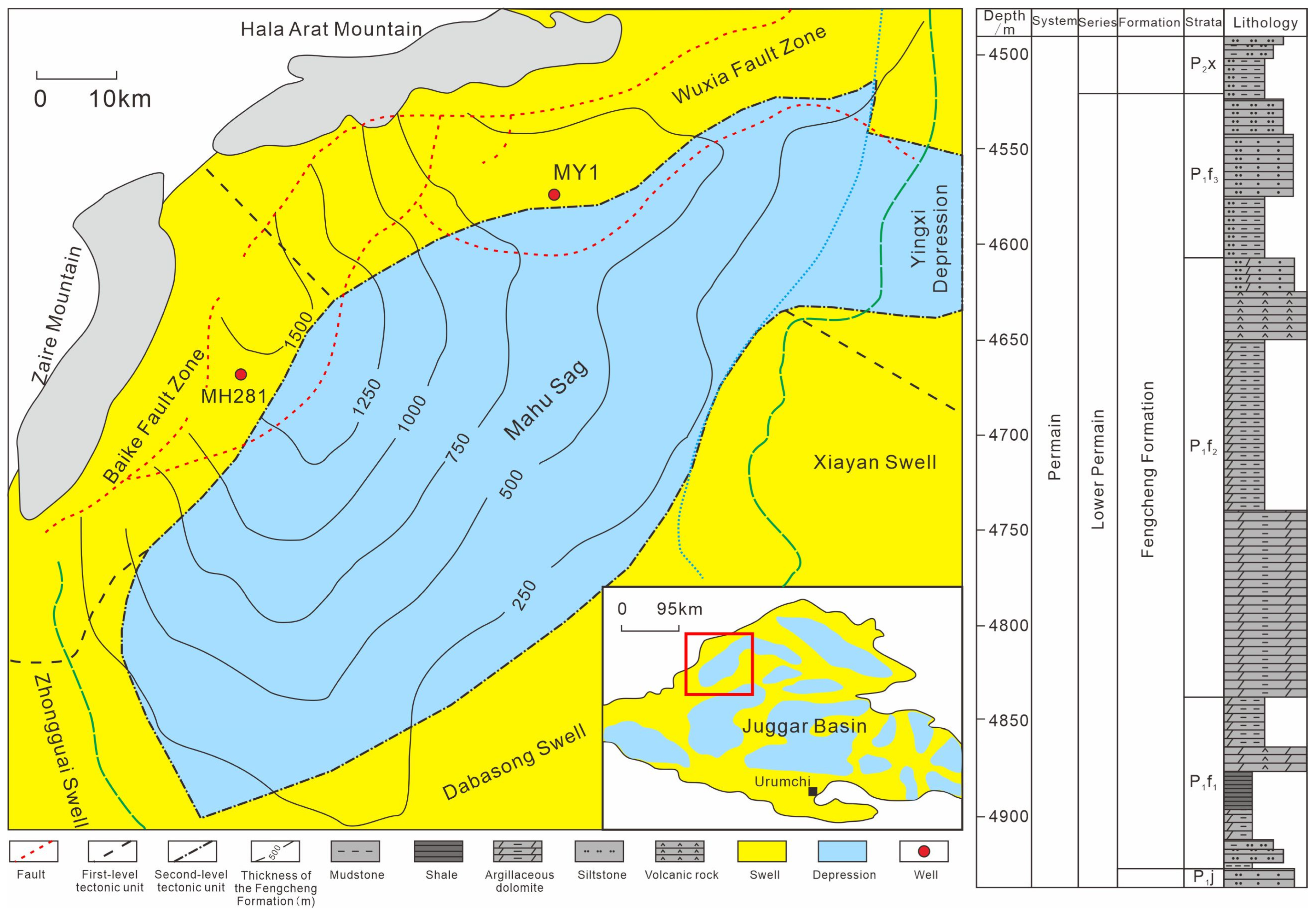
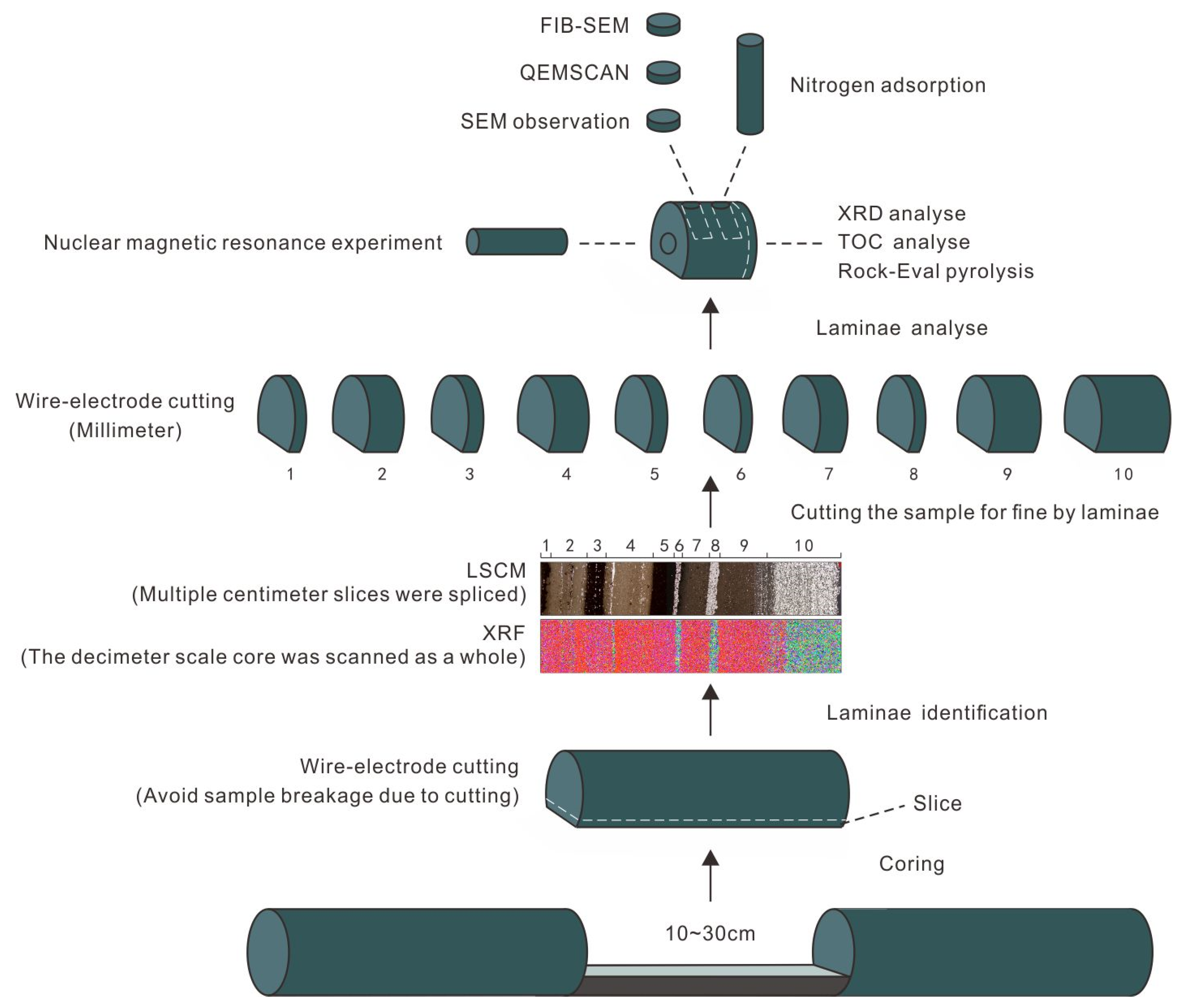

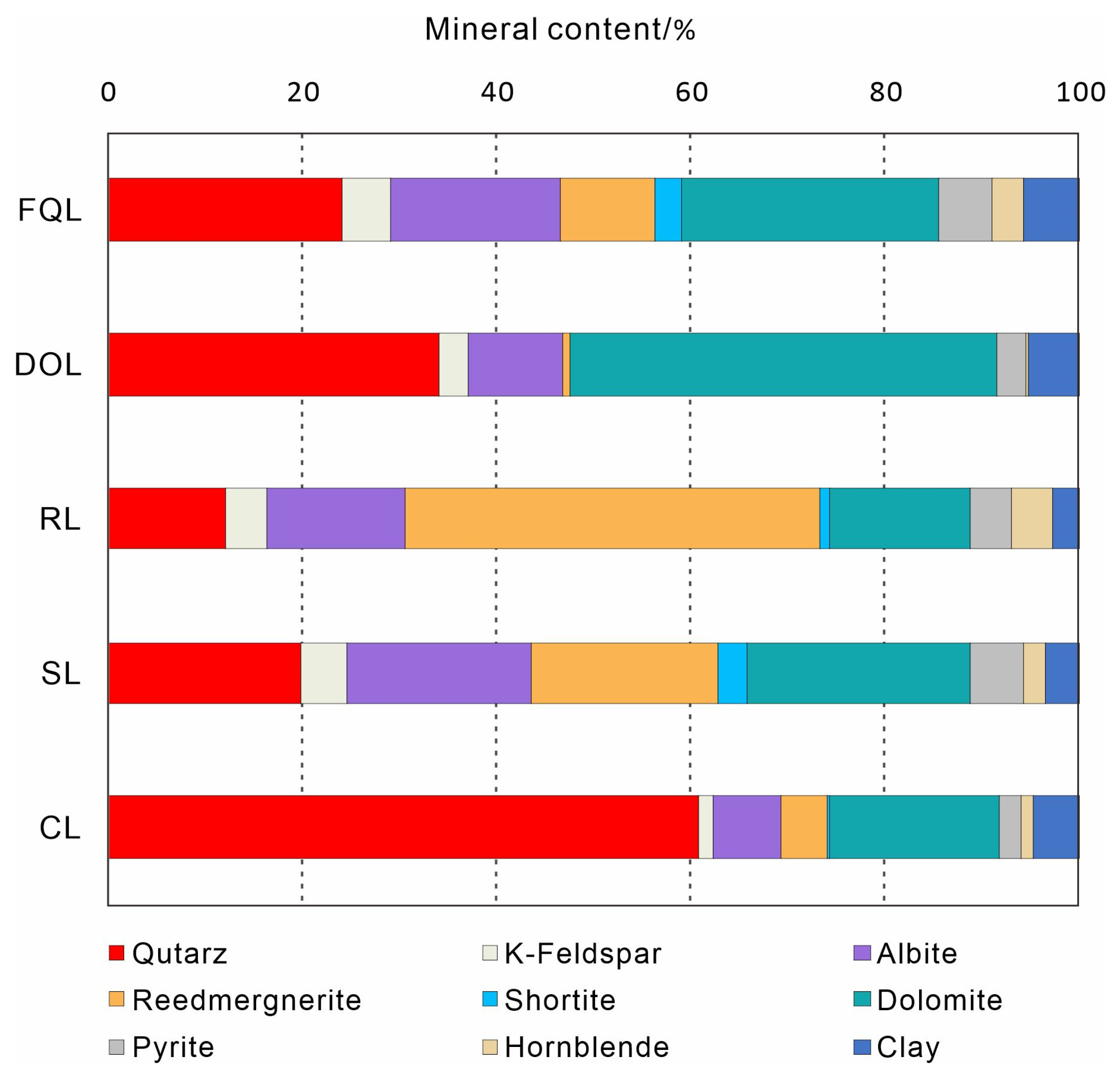
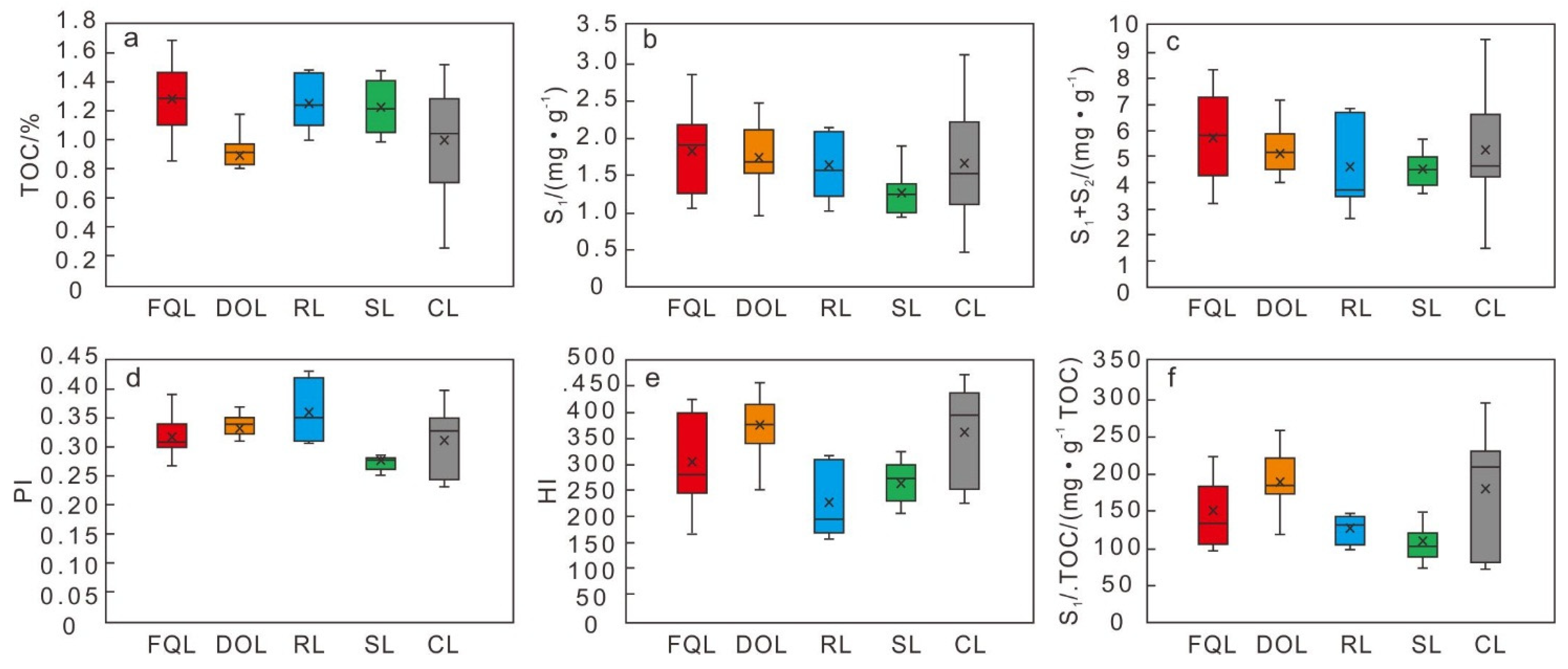


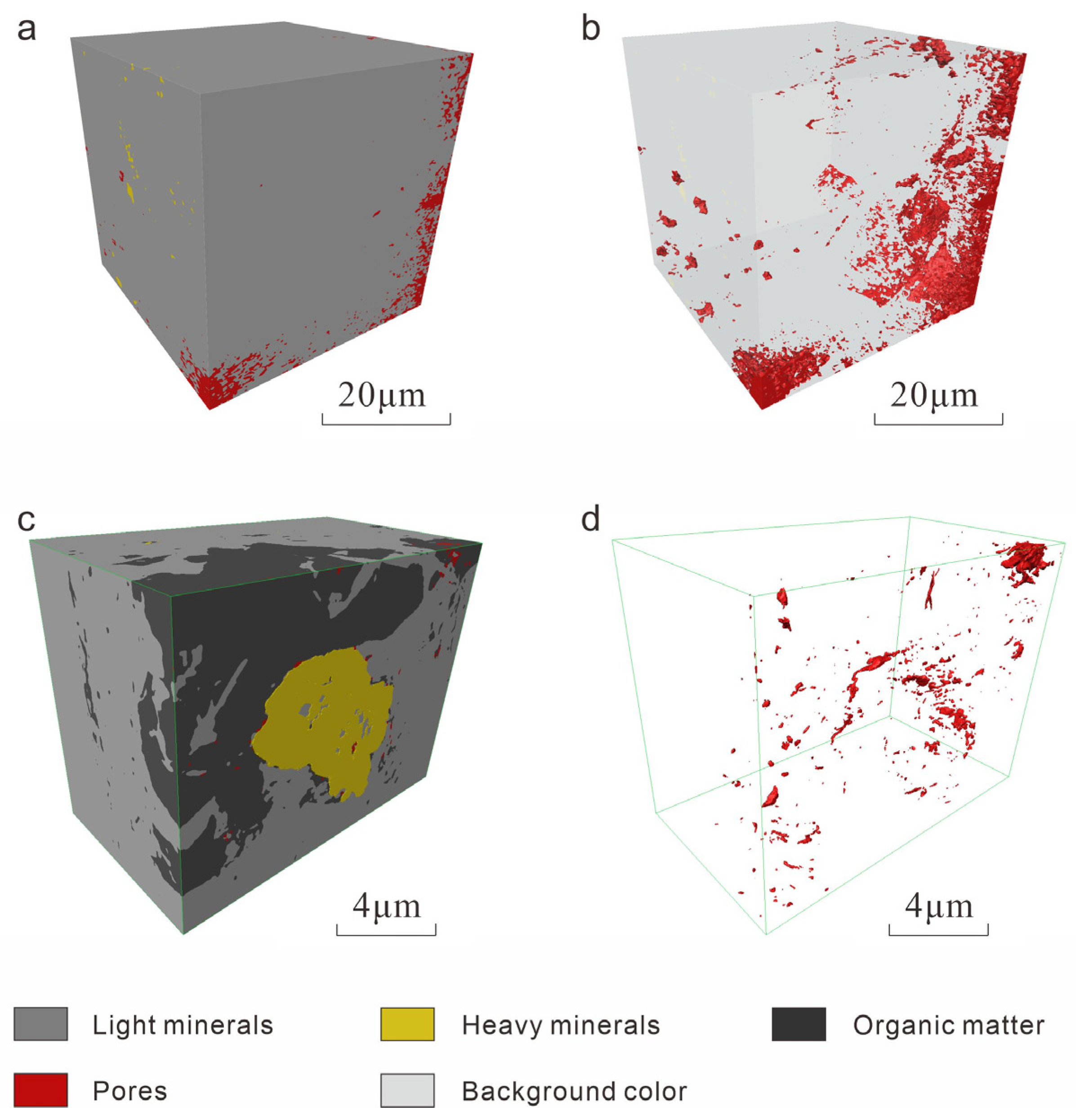


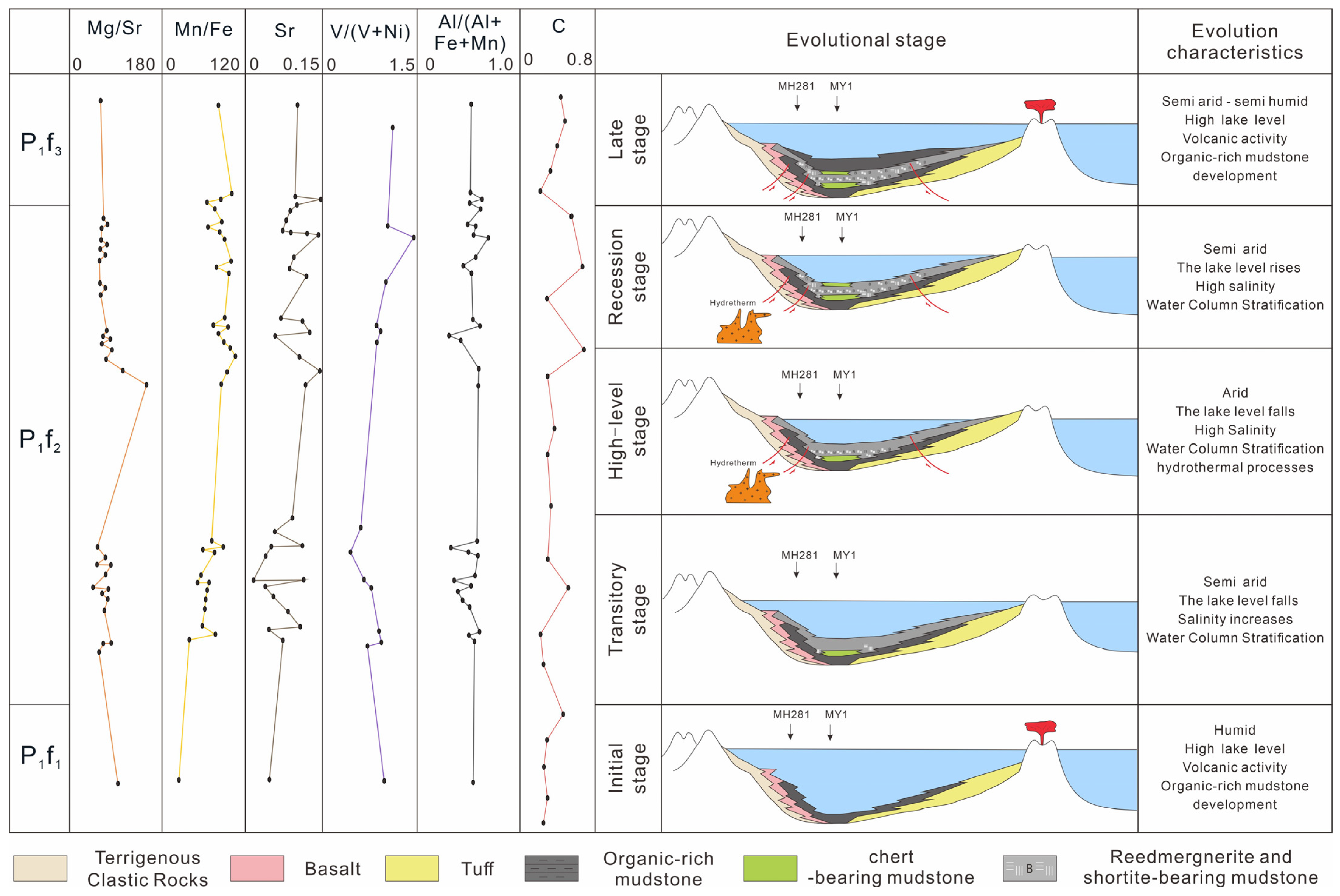
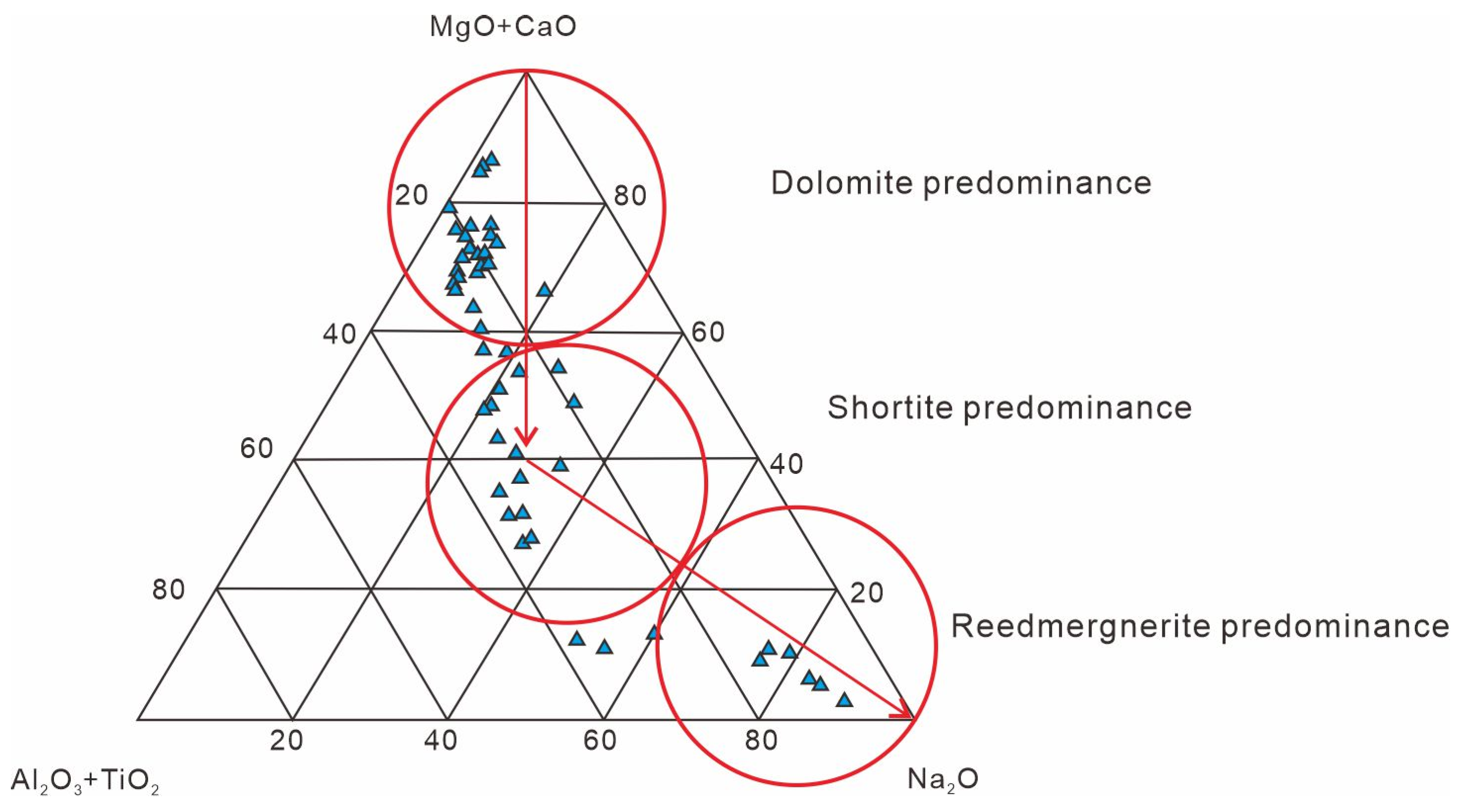
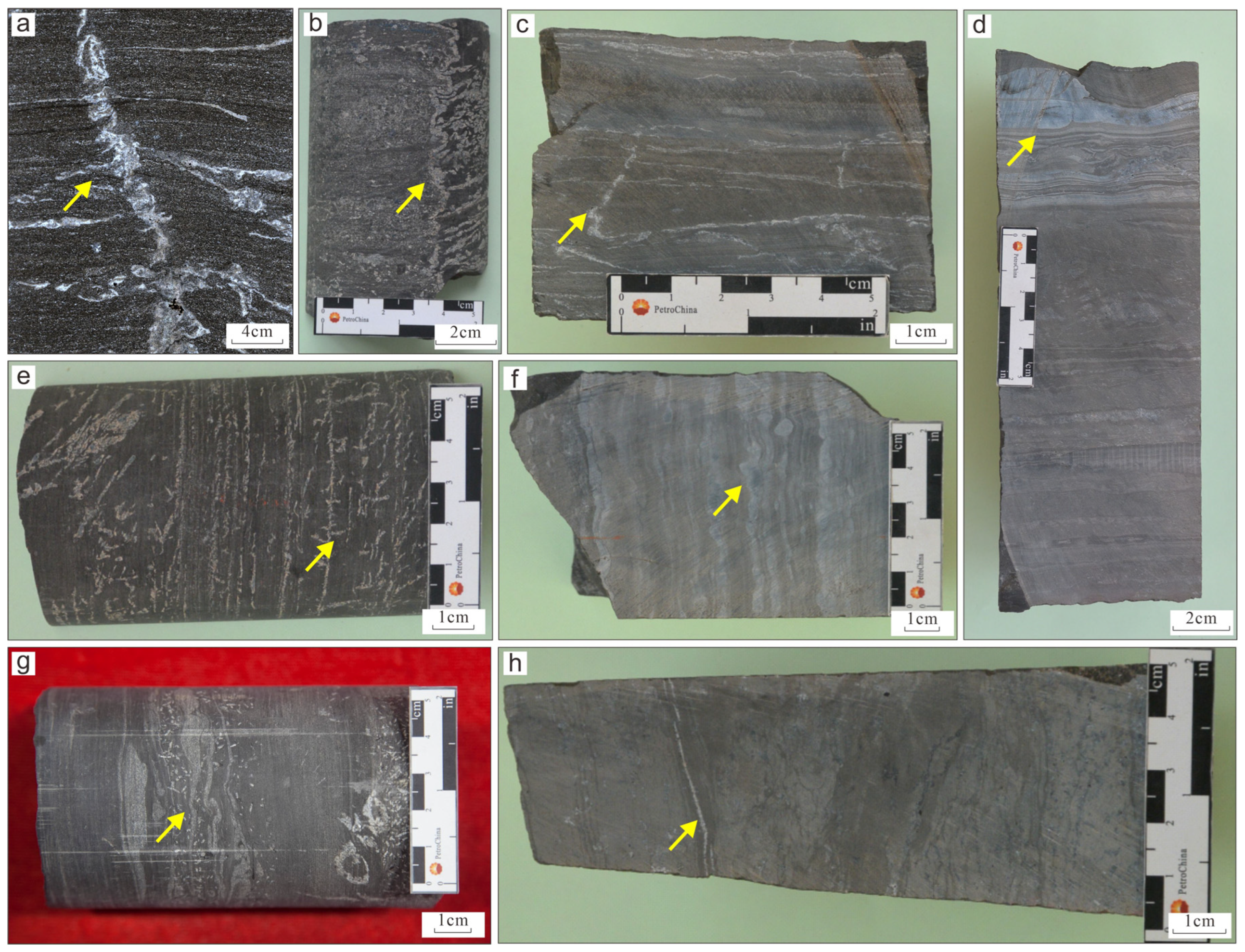


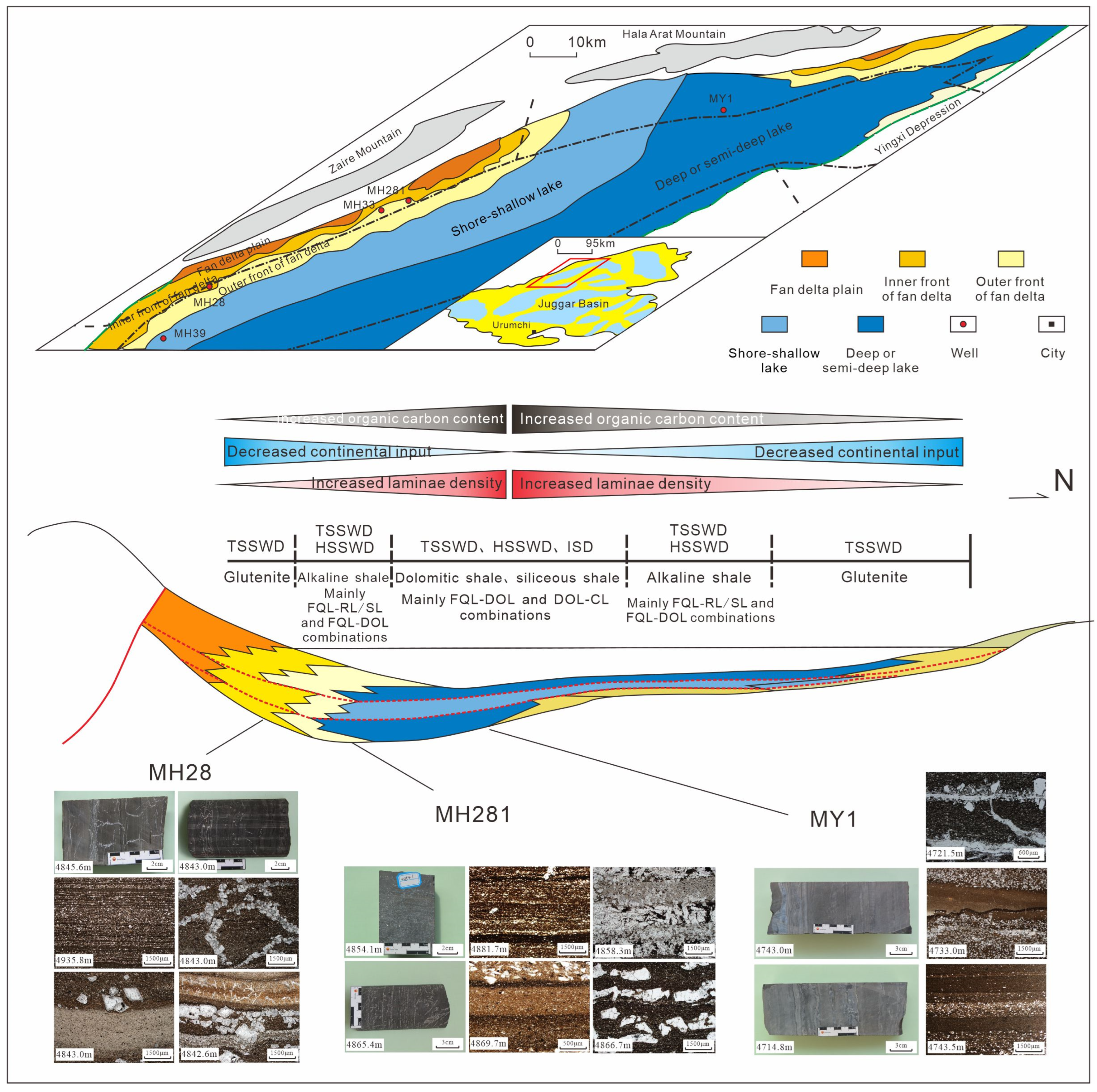
Disclaimer/Publisher’s Note: The statements, opinions and data contained in all publications are solely those of the individual author(s) and contributor(s) and not of MDPI and/or the editor(s). MDPI and/or the editor(s) disclaim responsibility for any injury to people or property resulting from any ideas, methods, instructions or products referred to in the content. |
© 2024 by the authors. Licensee MDPI, Basel, Switzerland. This article is an open access article distributed under the terms and conditions of the Creative Commons Attribution (CC BY) license (https://creativecommons.org/licenses/by/4.0/).
Share and Cite
Li, M.; Wu, S.; Zhu, R.; Hu, S.; Wang, P.; Cai, Y.; Zhang, S. Heterogeneity and Sedimentary Characteristics of Shale Laminae of Fine-Grained Sediments in Alkaline Lacustrine Strata in the Permian Fengcheng Formation, Mahu Sag, NW China. Energies 2024, 17, 962. https://doi.org/10.3390/en17040962
Li M, Wu S, Zhu R, Hu S, Wang P, Cai Y, Zhang S. Heterogeneity and Sedimentary Characteristics of Shale Laminae of Fine-Grained Sediments in Alkaline Lacustrine Strata in the Permian Fengcheng Formation, Mahu Sag, NW China. Energies. 2024; 17(4):962. https://doi.org/10.3390/en17040962
Chicago/Turabian StyleLi, Mengying, Songtao Wu, Rukai Zhu, Suyun Hu, Pengwan Wang, Yi Cai, and Surong Zhang. 2024. "Heterogeneity and Sedimentary Characteristics of Shale Laminae of Fine-Grained Sediments in Alkaline Lacustrine Strata in the Permian Fengcheng Formation, Mahu Sag, NW China" Energies 17, no. 4: 962. https://doi.org/10.3390/en17040962
APA StyleLi, M., Wu, S., Zhu, R., Hu, S., Wang, P., Cai, Y., & Zhang, S. (2024). Heterogeneity and Sedimentary Characteristics of Shale Laminae of Fine-Grained Sediments in Alkaline Lacustrine Strata in the Permian Fengcheng Formation, Mahu Sag, NW China. Energies, 17(4), 962. https://doi.org/10.3390/en17040962





